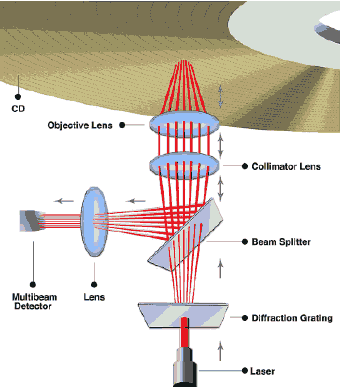KenWood 72x TrueX CD-ROM
1. General Description
Related Companies:
 Zen Research N.V. is a privately held IP license company that produces high
performance CD-ROM and DVD optical drive designs. Zen has an affiliate
in Tel Aviv, Israel that boasts a large multi-disciplinary research and development
team. Zen's United States affiliate is headquartered in Cupertino, CA.
Zen Research N.V. is a privately held IP license company that produces high
performance CD-ROM and DVD optical drive designs. Zen has an affiliate
in Tel Aviv, Israel that boasts a large multi-disciplinary research and development
team. Zen's United States affiliate is headquartered in Cupertino, CA.
![]() Kenwood
Technologies (U.S.A.) which is located in San Jose, California. was created
by Kenwood Corporation in 1997.
Kenwood
Technologies (U.S.A.) which is located in San Jose, California. was created
by Kenwood Corporation in 1997.
What is Zen ![]() technology?
technology?
Zen TrueX technology is a component set that enables optical drive manufacturers
to produce extremely fast CD and DVD drives that deliver sustained transfer
rates. Drives employing the TrueX component set read industry-standard disc
media and utilize standard CPU interfaces. TrueX component sets include optics,
detection devices and high speed ASICs. Drives made with TrueX technology illuminate
multiple tracks simultaneously, read them in parallel, and process the data
through a custom ASIC. This technology is compatible with all existing CD and
DVD formats and standards. KenWood drives are the only one for now which include
the Zen's TrueX technology.
History:
Performance improvements in optical drive technology have historically been
implemented by increasing the rotation speed of the disc and through CAV (Constant
Angular Velocity). Zen believes that these methods are no longer able to deliver
more than very small incremental performance gains. Optical disc drives with
real, average data transfer rates starting at 40X and beyond are possible using
a new technique based on Zen Research's TrueX technology. This technology promises
many benefits such as constant transfer rates, more disc-tolerant rotation speeds,
and compatibility with CDROM, DVD-ROM, CD Recordable, DVD Recordable, CD re-writable,
and DVD re-writable media.
How current CD-ROM and DVD-ROM work?
Today's most CD-ROM and DVD-ROM disc drives use a single highly concentrated
laser beam to read the digital signal that is encoded onto tracks of an optical
disc (CD or DVD). The single laser beam is directed at a single track of information,
which forms a continuous spiral on the disc that begins at the disc center and
spirals outward towards the outer edge. Variations (in data pit length) on the
disc surface cause variations in the reflected laser beam, which are detected
by an optical sensor.
The disc drive rotates the disc and the tracks run under the laser beam. The drive system has an optical servo control that allows the laser to exactly focus and follow the spiral path of the pits and lands, to stay focused on the "track". The laser is reflected at different intensities (one for pit and one for land), for different amounts of time (the length of a pit or land) as it passes over the spiral track. The reflected laser light is directed to a light sensitive detector that turns the light variations into a stream of serial data, representing the pattern of pits and lands on the disc. This data stream is amplified and sent to a microprocessor for interpretation. The laser, lenses to focus the beam, a mirror to point the reflected beam and the light sensitive detector, combined are known as an "optical pick-up".
 How
TrueX technology works?
How
TrueX technology works?
The Multiple Beam approach to illuminating and detecting multiple tracks
(see figure at left) uses a diffracted laser beam in conjunction with a multiple
beam detector array. The laser light from a conventional laser diode is sent
through a diffraction grating, which splits the beam into seven discrete beams,
spaced evenly to illuminate seven tracks. The seven beams pass through
a beam splitting (two way) mirror to the objective lens and onto the surface
of the disc. Focus and tracking are accomplished with conventional detection
elements on the central beam.  Three
beams on either side of the center beam are readable by a Multibeam detector
array as long as the center beam is on track and in focus.
Three
beams on either side of the center beam are readable by a Multibeam detector
array as long as the center beam is on track and in focus.
The reflected beams return from the disc via the same path and are directed to the multiple beam detector array by the reflective surface of the beam splitter (two way) mirror. The detector contains seven discrete detectors spaced to align with seven reflected tracks. Note that a standard single beam pick up is very similar. In a single beam pick-up, the diffraction grating would be removed and the detector would have a single data detection point.
What are Zen plans for near future?
Zen is currently developing a 25X level of performance for DVD (with Sanyo,
one of the top three optical pick-up providers, on a Multibeam pick-up for DVD)
and hopes also deliver higher levels of performance in future:

Zen has also planed a series of TrueX designs to provide increased performance
over competitors for optical storage in the next years:














